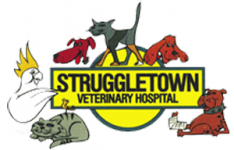Anaesthesia
Induction phase
This is where we give an intravenous anaesthetic drug, which rapidly makes the patient unconscious. It allows us to be able to pass a tube into the airway to deliver the anaesthetic gases, which will keep the patient anaesthetised during the procedure.
First, following a full physical examination and (recommended) blood tests to assess organ function, your pet is given a pre-medication. This is a sedative to reduce anxiety, relax your pet, and make the whole process smoother and safer. The pre-medication also includes pre-emptive strong pain relief.
Second, we place a catheter into the cephalic vein (on the top of the front leg). To place the catheter the fur must first be shaved over the top of the vein. A catheter is a thin, soft tube about 1 inch long with an injection port to allow delivery of drugs. This is taped to the leg and stays in place during and after anaesthetic and allows us to give intravenous fluids and drugs such as pain relief or intravenous antibiotics.
The induction agent is given into the vein “to effect”, that is; the correct dose for the body weight of the animal is calculated but then only the amount that is necessary for each individual patient is given.
A tube (endotracheal tube) of the appropriate size is then passed into the animal’s trachea. In cats, the larynx is first sprayed with local anaesthetic, as cats are prone to spasm of the larynx. This is not a problem for dogs.
The endotracheal tube is then tied into place with string up and over the animal’s nose, or behind the animal’s head. The tube has a soft, inflatable cuff on it to create a snug fit in the trachea. This is inflated with a small amount (1-2ml) of air.
Maintenance Phase
The patient is then attached to the gas anaesthetic system. This system provides oxygen and anaesthetic gas to the patient to keep them anaesthetised at the correct depth for the procedure.
All anaesthetised animals are kept warm, by a specially designed mat that constantly recirculates warm air through it. They are positioned on the anaesthetic table on a moulded cradle. They have ointment placed in their eyes to stop the corneas becoming dry.
Monitoring anaesthetic is a complex task. It is best achieved by constant monitoring by a qualified veterinary nurse or vet, with assistance from anaesthetic monitoring equipment. Every animal has an anaesthetic record filled out.
During the procedure, the patient is monitored to keep them at the right depth of anaesthetic – that is, if too lightly anaesthetised then the patient might have some reflex movements when surgery is being performed and if too deep then the heart or breathing rates may decrease.
The following variables contribute to our assessment of anaesthetic depth and are each measured and recorded every five minutes during the procedure: heart rate, respiratory rate, body temperature, tissue oxygen saturation and expired air carbon dioxide concentration. Critical patients also have their blood pressure and electrocardiograph (ECG) measured whilst under anaesthetic.
Some variables are measured manually by oesophageal stethoscope (a tube placed into the oesophagus to rest near to the heart and connected to the earpieces of a stethoscope) and checked against those values measured by the machines. Other values are measured by monitoring equipment – pulse oximeter, capnograph, and Doppler.
The pulse oximeter has a small clip that is attached to the patient’s tongue. This measures the oxygen saturation of blood at the tissue level and should always be maintained at greater than 95%. This machine also checks the pulse rate. The capnograph measures the respiratory rate and the level of the carbon dioxide in the expired gases.
The Doppler blood pressure gauge measures the systolic (maximum) blood pressure that occurs as the heart contracts. This must be maintained to ensure a healthy supply of oxygen and nutrients to the tissues during anaesthesia.
Recovery Phase
Once the procedure is nearing completion, the anaesthetic gas level will be slowly decreased, over about 5 minutes, to allow the animal to gradually regain consciousness.
The animal will be given extra pain relief if it is necessary, to help facilitate a smooth recovery.
Once the gas is turned off, the animals are left to breath 100% oxygen for about 5 minutes, then they are allowed to breath regular room air again. Once they show signs of regaining awareness then the endotracheal tube is removed and the animal is placed into a recovery cage. This is lined with a padded blanket and they are kept warm with hot water bottles or a heating mat.
Most animals regain consciousness within 10 minutes of stopping the anaesthetic, can sit up within about 1 hour and are able to walk within 2 or 3 hours. This varies a lot depending on the procedure and the time spent under anaesthetic. They normally need to rest in hospital for at least 6 hours after an anaesthetic.
Get In Touch!
Address:
148 Barker St,
Randwick NSW 2031
Contact:
(02) 9398 8000
reception@struggletownvet.com.au
Newsletter
Subscribe to our monthly newsletter
Hours:
Mon to Fri: 7:30am - 9:00pm
Sat: 9:00am - 5:00pm
Sun: 9:00am - 1:00pm
Providing Quality Vet Care Near:
Randwick, Coogee, Kingsford, Daceyville, Kensington, Bronte, Waverley, Queens Park, East Gardens, Pagewood, Hillsdale, Maroubra.
